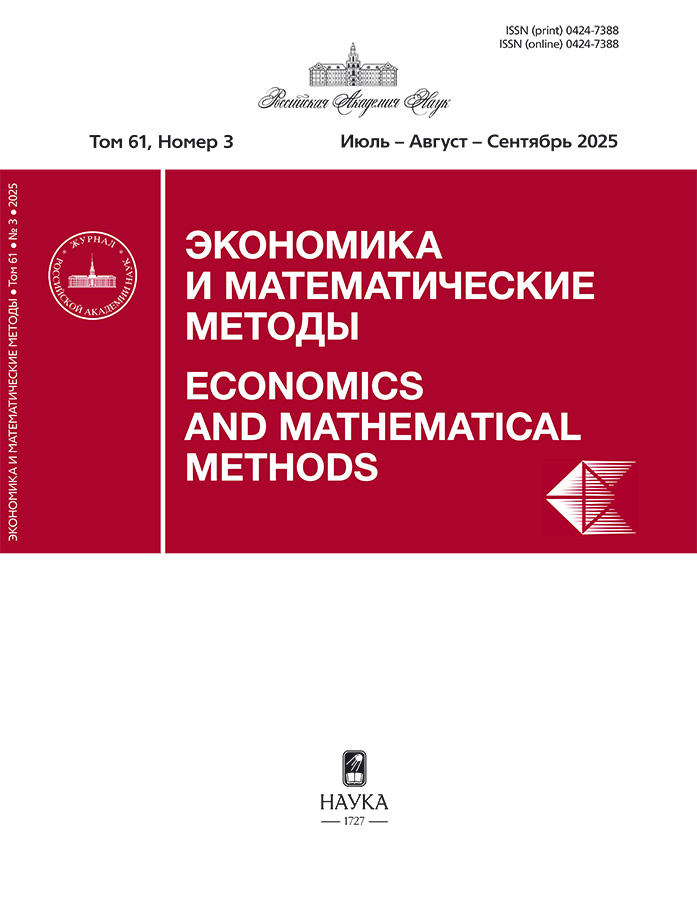Economics and Mathematical Methods
Journal “Economics and Mathematical Methods” is an open ground for international communication and information exchange, for sharing the results of fundamental and applied research among the specialists of academic, analytical and expert communities. The Journal is aimed at the highest level in scientific discussion of the problems, methods of research and economic development, inviting the most expertized participants — researches and practitioners. Utmost goal of the Publishers is to provide conditions for free discussion and sharing ideas to advance creative propositions and results of theoretic researches into the real economy. Major mission of the Journal is to provide opportunity to publicize the results of scientific works as well as share the knowledge and experience for scientific researchers. The Editorial board of the Journal aims to make it the leading journal among the serious scientific and education publications, well known in the world economic community, informing about the last advances in economic sciences. The articles accepted for further publication are validated as actual by the reviewers — their problems and solutions, their novelty and relevance of results; these requisites being the necessary terms for publications.
Media registration certificate: № 0110156 от 04.02.1993
Current Issue
Vol 61, No 3 (2025)
Theoretical and methodological problems
The Social Optimum and the Ordinalist Theory of Utility
Abstract
 5-16
5-16


Analysis of the theory of capital
Abstract
The search for a standard measure of value remains a significant theoretical challenge. Classical economists such as Smith, Ricardo, and Marx believed in a uniform measure of value. However, neoclassical economists argued that the social value of wealth cannot be measured in an objective and uniform way. In recent years, a new theory of value emerged. This theory, building on the foundations of classical economics and drawing inspiration from Newtonian mechanics, constructed an axiomatic system of value mechanics. It also deduced a system of value dimensions that can be applied in the field of economics. This new approach preliminarily solved the problem of calculating value using a uniform measure. Accordingly, we can now use the Euler–Lagrange equation to explore the process of optimal capital motion. This equation allows us to analyze theoretical problems of capital, including the value calculation of absolute surplus value, relative surplus value, and irrational economic behavior. This paper aims to establish a system for the measure of value, with two-fold character — natural and social, similar to the measurement system in natural sciences, offering standardized material properties for measurement units corresponding to value dimensions.
 17-27
17-27


World economy
Assessment of financial contagion of the stock markets of Russia, USA, China and European countries in 2019–2024, using the copula method
Abstract
 28-42
28-42


Problems of national economy
Consideration of the impact of risk situations on the beneficiaries of investment projects
Abstract
 43-55
43-55


Industrial problems
Assessment of the effects of foreign trade policy on the sunflower seed market in Russia
Abstract
 56-68
56-68


Pharmaceutical exports and exchange rate dynamics: An empirical approach to the relationship
Abstract
One of the main factors affecting the export of pharmaceutical products is the exchange rate and its changes. Most studies confirm that there is a significant correlation between export volume and exchange rate. Changes in the exchange rate have a direct and indirect impact on country’s exports. This effect is manifested through the state of the balance of payments, the formation of supply and demand in the money market at the macro level, inflation, the state budget and other similar macroeconomic processes and indicators. Therefore, this article uses the case of Uzbekistan to carry econometric analysis of the relationship between the export of pharmaceutical products and exchange rate dynamics. First, the dynamics of the two variables were tested for nonstationarity using the Augmented Dickey–Fuller test, or ADF-test. Based on the results obtained, the hypothesis about the existence of cointegration in time series was tested using the Engel–Granger method. In the study, the direction of correlation was determined using the Granger causality test. All analyzes were performed using EViews software. The results confirmed the presence of a positive relationship between the export of pharmaceutical products and the dynamics of the exchange rate.
 69-77
69-77


Ecological problems
Assessment of the carbon footprint of sectors of the Russian economy and measures for industrial decarbonization
Abstract
 78-91
78-91


Mathematical Modeling Features of the Sustainable Development Mechanisms
Abstract
 92-103
92-103


Mathematical analysis of economic models
Calibration of ARIMA-GARCH-Model of Basic Asset Price Based on Market Option Quotes
Abstract
 104-115
104-115


Multidimensional Coherent Risk Measures and Their Properties
Abstract
Coherent risk measures are widely used in practice to calculate risk. Multidimensional coherent risk measures are important to use for companies and banks operating in different international markets. Here we introduce an example which clearly shows that multidimensional coherent risk measures reduce capital requirements on multi-asset or multi-currency markets. In this paper we consider two different approaches to define multidimensional coherent risk measures. The first approach is based on a cone-based exchange rate set, whereas the second employs random sets to account for liquidity constraints and other market frictions. Also constructive approach for multidimensional risk measures using one-dimensional law invariant ones is considered. We introduce the example of coherent risk measure which cannot be represented by the constructive approach. Two important properties of multidimensional risk measures such as law invariance and space consistency are investigated and their equivalent properties in terms of determining set and acceptance set are given. Then we consider a multidimensional generalization of Tail VaR and show that it satisfies space consistency and law invariance properties and provide an example which shows that multidimensional portfolio risk estimation using this risk measure gives an adequate result. JEL Classification: C39, D81. UDC: 519.25. For reference: Kulikov A. V., Volkov N. V. (2025). Multidimensional coherent risk measures and their properties. Economics and Mathematical Methods, 61, 3, 116–125.
 116-125
116-125


Forecasting the Return and Volatility of Financial Instruments with Fuzzy Inference Systems and ARMA-GARCH Models
Abstract
 126-138
126-138















